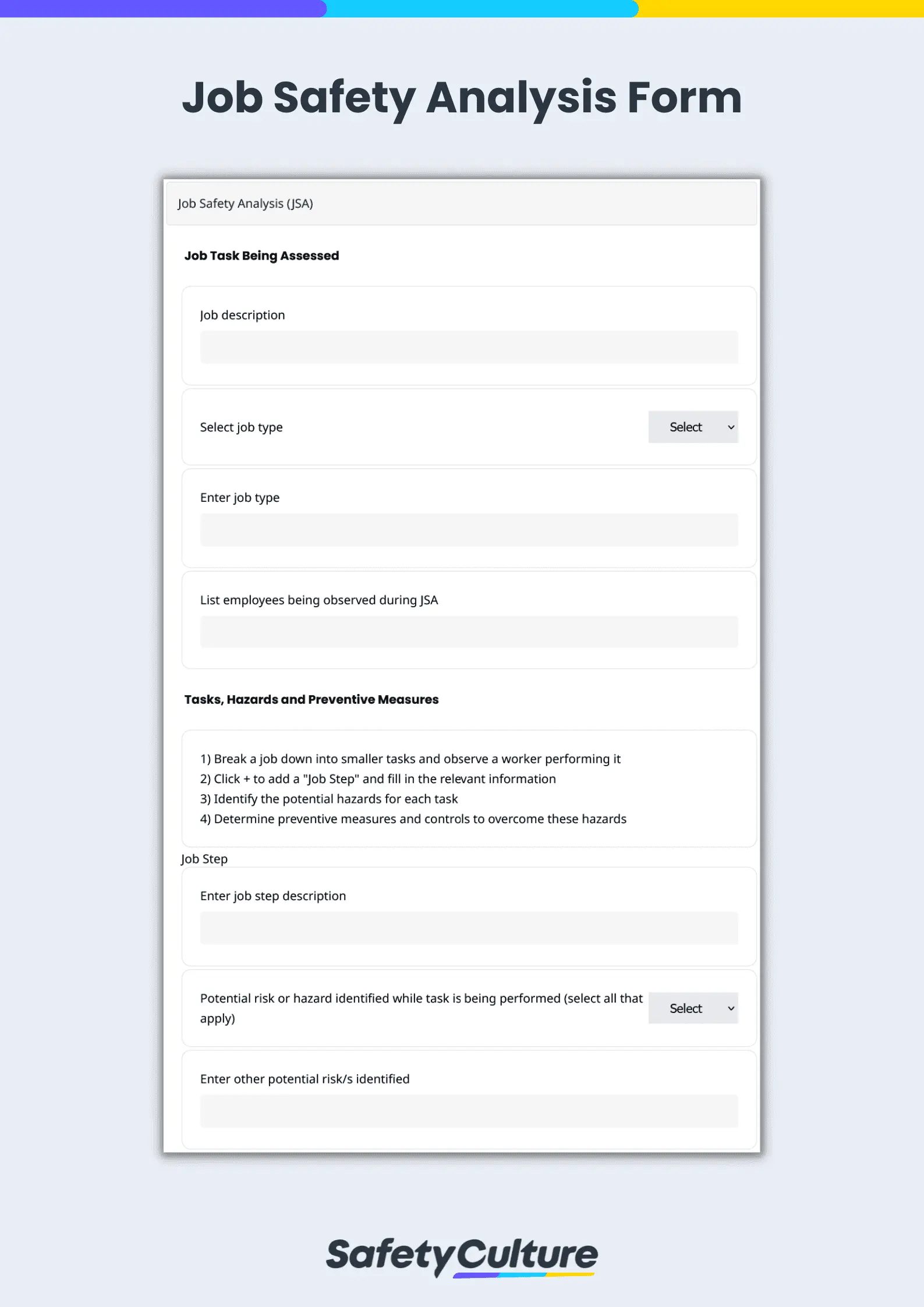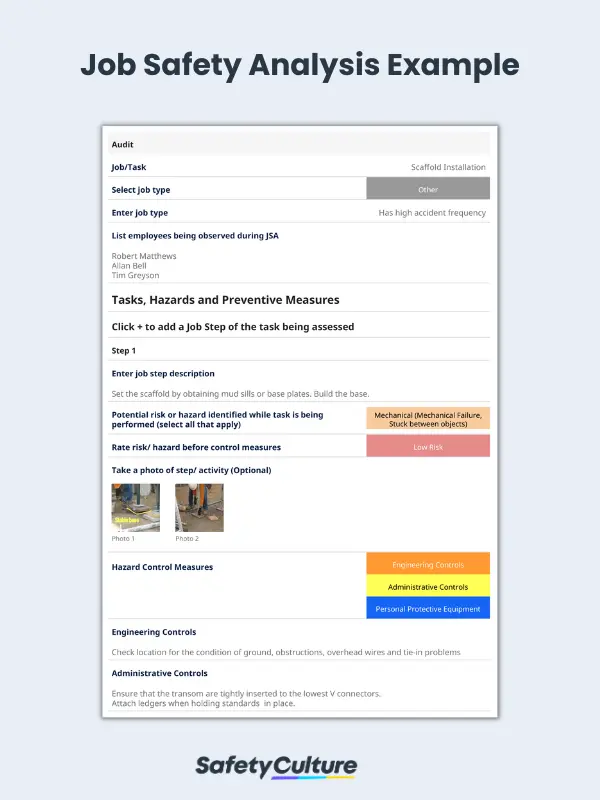What is a JSA Template?
A JSA template or Job Hazard Analysis (JHA) form is a useful tool for observing and breaking down high-risk tasks into individual steps, identifying the potential hazards for each task, and determining preventive measures and controls to overcome these hazards. Supervisors and employees work together in accomplishing JSA templates to ensure that both have a good understanding of the hazards and come up with safety measures.
What Does JSA Mean?
JSA is an abbreviation term for Job Safety Analysis, which is a systematic technique of analyzing potential hazards for each task needed for a job. It helps integrate accepted health and safety protocols into a particular organizational operation to implement the safest way to complete the job.
Often, JSA is used interchangeably with Job Hazard Analysis (JHA). While these two approaches both aim to help organizations identify and mitigate hazards involved in various jobs, they can pertain to slightly different things. This may be dependent on the industry, relevant regulations, and other considerations revolving around the nature of work.
Nonetheless, both JSA and JHA form part of a more holistic approach to building a safety culture not just in the workplace but also in the minds and attitudes of employees.
Why is the Analysis Important?
A JSA is important because it increases job knowledge, establishes teamwork, serves as a health and safety standard and teaching aid, and supports accident investigations at work. Dangerous jobs benefit the most from a JSA because it can reduce or eliminate hazards that cause serious injuries or fatalities.
According to the US Bureau of Labor Statistics’ recent workplace fatality census, the following are examples of the most dangerous jobs in the US that would benefit significantly from a JSA process:
- Logging workers
- Fishers and hunting workers
- Roofers
- Aircraft pilots and flight engineers
- Structural iron and steelworkers
- Driver/sales workers and truck drivers
- Refuse and recyclable material collectors
- Underground mining machine operators
These jobs require rigorous safety analyses to ensure the employees’ health and safety in the workplace. To help organizations perform such a complicated process, using tools like JSA templates is crucial to streamline each step of the analysis.
Legal Considerations
A JSA can be conducted on many jobs in the workplace, but priority should go to the types of jobs that have:
- the highest injury or illness rates;
- the potential to cause severe or disabling injuries or illness, even if there is no history of previous accidents;
- the risk of resulting in a severe accident or injury due to simple human errors;
- undergone changes in processes and procedures; and
- a complex nature to require written instructions.
While federal regulations generally require hazard assessments, the US Occupational Safety and Health Administration (OSHA) provides detailed guidelines for conducting a JHA or JSA in this document. As one of the tools used for hazard assessments, regularly performing a job safety analysis can help proactively ensure compliance with OSHA standard 1910.132:
“The employer shall verify that the required workplace hazard assessment has been performed through a written certification that identifies the workplace evaluated; the person certifying that the evaluation has been performed; the date(s) of the hazard assessment; and, which identifies the document as a certification of hazard assessment.”
With these in mind, complying with workplace safety standards can be helped by using a JSA checklist or template. This tool can standardize the way safety assessments are conducted, control measures are recommended, and JSA results are documented.
What to Include in a JSA Template
To help you ensure a comprehensive analysis, your template must include the following key sections and elements:
- Job task being assessed – The supervisor or safety officer will describe the job and identify the workers observed during the analysis.
- Hazards and safety measures – The observer will determine the potential hazard for each task being performed and come up with control measures to minimize or eliminate the hazard.
- Recommendations – Recommendations on how each task can be accomplished safely will be recorded on the JSA and submitted for review and implementation.
How to Conduct a Job Safety Analysis Using a Template
A JSA template is used when performing a JSA procedure and is used to generate a safety and recommendation report. These four key steps can help you get started with performing a more effective analysis:
1. Choose the right job.
Pick a job that has a high accident frequency and severity, which results in serious injuries. Also, consider the following factors when deciding what jobs you need to conduct a JSA for:
- A job that has exposure to hazardous and harmful products
- Newly established jobs in which there is a lack of experience and where hazards may not be anticipated
- Modified jobs due to changes in procedures
- Infrequently performed jobs or non-routine jobs put workers at greater risk
2. Break a job into steps.
Don’t be too general yet not too detailed during this part of the analysis. As a rule of thumb, there should be 10 steps, depending on the complexity of the job. Describe each step by starting with verbs or action words.
It can also help to make notes about “what is done,” not “how it is done” when observing how jobs are performed during normal times and situations.
3. Identify potential hazards.
When identifying hazards, make sure to ask the right questions:
- Is the worker at risk of falling, slipping, and tripping?
- Is the worker exposed to extreme temperatures?
- Is the worker at risk of getting caught between objects?
- Is the worker exposed to explosive and combustible materials?
- Is the worker at risk of electrocution?
4. Set preventive measures.
Eliminate the hazards by using a different process, modifying an existing one, improving the environment, changing tools, or reorganizing work procedures. Using machine guards, enclosures, workers’ booths, or similar devices can also be done to contain certain hazards if they’re impossible to eliminate.
After conducting a JSA, ensure continuous safety training and other initiatives by considering discussing safety topics regularly. This can be done by conducting daily or weekly toolbox talks. In relation to job safety analysis, here are some sample toolbox talk topics you can cover:
- Construction: Fatal Four Hazards Discussion | Download Template
- OSHA: Preventing Slips, Trips, and Falls | Download Template
- PPE Safety Toolbox Talk: Top 8 Protective Gear | Download Template
- Electrical Safety Toolbox Talk: Hazards, Dos and Don’ts | Download Template
- Working at Heights: Hazards, Planning, and Safety Tips | Download Template
Job Safety Analysis Example
Writing a job safety analysis with the help of a free JSA template can seem challenging at first. With continuous practice, though, workers can master breaking down their job tasks, identifying hazards, and implementing controls.
To guide you, below is an OSHA example of a job hazard analysis:
- Job Location: Metal Shop
- Analyst: Joe Safety
- Date: January 31, 2023
- Task Description: The worker reaches into the metal box to the right of the machine, grasps a 15-pound casting, and carries it to the grinding wheel. The worker grinds 20 to 30 castings per hour.
- Hazard Description: Picking up a casting, the employee could drop it onto his foot. The casting’s weight and height could seriously injure the worker’s foot or toes.
- Hazard Controls:
- Remove castings from the box and place them on a table next to the grinder.
- Wear steel-toe shoes with arch protection.
- Change to protective gloves that allow a better grip.
- Use a device to pick up castings.
Here is another example of a JSA when a template is used and exported into a report:
How an Organization Cracked the Safety Culture Code Through Conducting JSAs
JSA can be one of the most critical safe work practices that workers could ever do, especially when working in high-risk conditions such as in the construction industry.
Forward-thinking leaders in one of America’s largest roofing companies needed a better way to efficiently manage teams working on dangerous projects across the US. The solution changed the corporate culture from the bottom up—every worker on every roof does one inspection using SafetyCulture every day.
“Once we started preaching that message to them that this is an empowerment tool, it just caught like wildfire… We are now able to attribute volume of quality inspections with a decrease in incidents and injuries, and we all win.” – Ro Lewis, Director of Health and Safety
FAQs About JSA Templates
The frequency of reviewing and updating JSA checklists and templates can vary depending on several factors, including the nature of the job tasks, the workplace environment, and any changes in equipment, processes, or regulations.
Ultimately, the key is to maintain a proactive approach to reviewing and updating these tools to ensure that they accurately reflect the current state of job tasks and safety measures. Promptly addressing changes and identified hazards helps prevent workplace accidents and injuries.
JSA templates can play a significant role in contributing to a company’s safety culture in several ways:
- Increased Awareness
- Communication
- Employee Involvement
- Training and Education
- Standardization
- Accountability
- Continuous Improvement
- Positive Reinforcement
- Leadership Involvement
- Reduced Incidents
- Crisis Preparedness
The key difference between a risk assessment and a JSA lies in their scope and purpose. A risk assessment is a comprehensive process that evaluates a wide range of risks across an organization or project, while a JSA is a task-specific analysis that focuses exclusively on safety hazards associated with a particular job task. Both processes are valuable in managing workplace safety, but they are used in different contexts and for different objectives.



